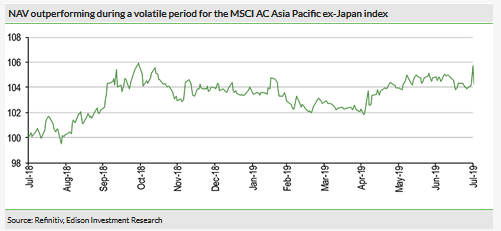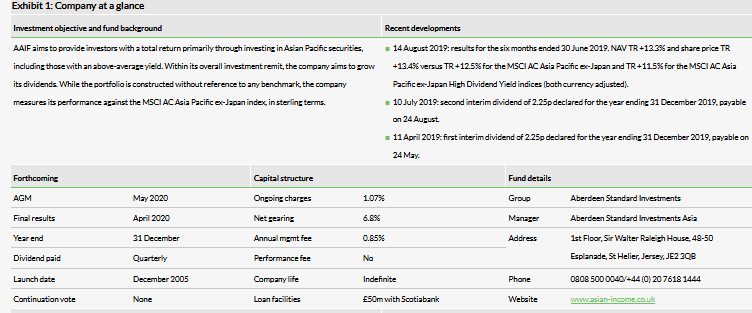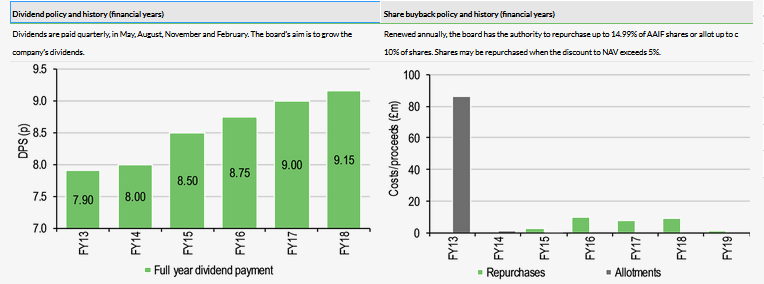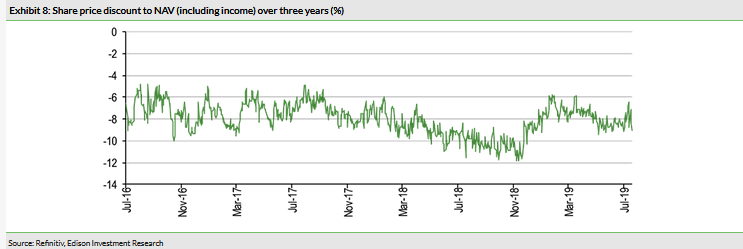Aberdeen Asian Income Fund (LON:AAIF) aims to generate an above-average level of income and long-term capital growth, even in challenging times, from a diversified portfolio of Asia Pacific equities. Data from the fund’s manager Aberdeen Standard Investments (ASI) Asia highlight the importance of income in the region; since 2000, c 50% of share price total returns have been from reinvested dividends and corporates are supportive of dividend growth. AAIF has generated double-digit NAV and share price total returns over the last decade and currently offers a 4.4% dividend yield. The dividend is well covered and the fund has c 0.9x the FY18 annual distribution in revenue reserves.

The market opportunity
The Asia Pacific region has above-average growth prospects, due to a variety of factors, including a growing middle class. Earnings valuations are also relatively attractive, while a culture of higher dividends means Asian equities now offer a comparable yield compared with global equities.
Why consider investing in AAIF?
Exposure to region with above-average growth and attractive valuations, with differentiated geographic weightings versus its peers.
Long-term outperformance versus the Asia Pacific stock market and it outpaced a strong market in the first half of 2019.
High-conviction, fundamental approach, with well-resourced team seeking high-quality companies with high and growing dividends that can be held for the long term (attractive 4.4% dividend yield fully funded from portfolio income).
Potential for higher rating
AAIF’s current 9.0% share price discount to cum-income NAV compares with the average discounts of 8.8%, 8.0%, 6.5% and 2.2% respectively over the last one, three, five and 10 years. There is scope for the discount to narrow given the fund’s performance track record and its two closest peers in the AIC Asia Pacific Income sector are consistently rated more highly. AAIF has increased its dividend for the last 10 consecutive years and currently yields 4.4%.




Market outlook: Attractive prospects in the region
Exhibit 2 (LHS) illustrates that over the last five years, the performance of Asia Pacific equities has significantly outpaced that of UK shares (both in sterling terms). The Asia Pacific region has above-average growth prospects, helped by structural trends including increased demand for premium products, rising urbanisation and the proliferation of ecommerce. In its July 2019 World Economic Outlook, the International Monetary Fund forecast growth in emerging and developing Asia of 6.2% pa in both 2019 and 2020, which is considerably higher than 1.9% in 2019 and 1.7% in 2020 for advanced economies.
Despite the region’s superior growth expectations, Asian shares look relatively attractively valued; the Datastream Asia ex-Japan index is trading on a forward P/E multiple of 12.6x, which is a 13.3% discount to the Datastream World index forward P/E of 14.6x. Asia ex-Japan is also trading on a lower premium to its 10-year average – 2% versus 7% for global equities – and with the trend towards higher dividend payments, the region now has a comparable dividend yield to the world market. The investment backdrop of higher growth potential and more attractive equity valuations suggests that global investors may benefit from exposure to the Asia Pacific region, perhaps favouring high-quality companies offering competitive dividend yields given current macro uncertainties, such as the ongoing trade dispute between the US and China.

Fund profile: High yield and long-term capital growth
AAIF was launched in December 2005 and is registered in Jersey as a closed-end investment company. It aims to generate an attractive total return, benefiting from the growth prospects of Asian companies, including those with above-average dividend yields. AAIF aims to grow its dividends. The company is managed by ASI Asia, which is based in Singapore and is the Asia Pacific headquarters of Standard Life (LON:SLA) Aberdeen. ASI Asia has input from investment teams around the region. AAIF is able to invest in any geographies or sectors in the Asia Pacific region, in companies across the market-cap spectrum. While its portfolio is constructed without reference to a benchmark, performance is measured against the MSCI AC Asia Pacific ex-Japan and the MSCI AC Asia Pacific ex-Japan High Dividend Yield indices (both currency adjusted). The manager can invest in preference shares, debt, convertible securities, warrants and equity-related securities, and off-benchmark stocks (which includes Japan); although, in aggregate, these securities are less than 10% of the fund’s NAV. AAIF’s portfolio typically contains between 40 and 70 holdings; a maximum 20% of total assets is permitted in a single issuer. The board has recently authorised the manager to write covered put and call options and to undertake stock lending to generate additional revenue, although these features will be used sparingly. Gearing of up to 25% of NAV (up to 15% of NAV in normal market conditions) is permitted; net gearing at end-June 2019 was 6.8%.
The fund manager: ASI Asia
The manager’s view: Improving earnings estimate revisions
We spoke with Yoojeong Oh, one of AAIF’s portfolio managers, who suggests the outlook for corporate earnings is improving, while Asian companies still have significant cash on their balance sheets. Over the last 12 months, there have been a series of negative earnings estimate revisions, especially in the technology sector as the trade dispute between the US and China has escalated. However, the manager notes that high-quality companies are now experiencing upward estimate revisions, so she is hopeful that ‘earnings are turning around’. Oh highlights AAIF’s positions in technology bellwethers Taiwan Semiconductor Manufacturing Company and Samsung Electronics (KS:005930). She says these companies are at the top of the supply chain and the team is upbeat about their potential in 2020, following on from a lower-growth environment this year. Oh is encouraged by these companies’ prospects over the next three to five years, partly due to increased demand for artificial intelligence technologies, which require many complex semiconductor memory chips; the team has taken advantage of share price weakness to increase AAIF’s exposure to these firms.
The manager says at the start of this year, company valuations looked ‘very attractive indeed’ given the long-term growth potential in the Asia Pacific region. AAIF has a bias towards the South East Asian economies, where there are very favourable demographic trends, including a growing middle class; the fund is skewed to domestic rather than export-led growth, taking advantage of the significantly higher economic activity in emerging compared with developed markets.
Asset allocation
Investment process: Seeking mispriced securities
The manager’s philosophy is that a company’s share price is driven by the firm’s fundamentals, but over shorter periods, stock markets can be inefficient, leading to mispriced securities. Oh and the rest of the investment team undertake their own fundamental research and due diligence, including many face-to-face meetings, seeking companies that are trading at a discount to their estimated intrinsic worth. The focus is on high-quality businesses with strong franchises exposed to long-term growth trends in the Asia Pacific region, which have strong balance sheets that can support healthy dividend payments. AAIF’s investible universe contains all companies in the region with in-house ‘buy’ or ‘hold’ recommendations. Portfolio turnover is low, averaging c 10–15% pa, implying around a seven- to 10-year holding period (in 2018, seven new positions were initiated, whereas there were 10 complete disposals and portfolio turnover was 13%). Oh says the level of activity in the fund is driven by available investment opportunities, with ideas generated by the more than 50-strong Asian team of investment professionals in eight countries in the region highlighting ideas suitable for an income fund. She says the Asian market is now more income friendly, offering a greater number of potential investee companies.
The manager stresses the importance of environmental, social and governance engagement with company managements as part of the research process. She highlights China Resources Land, which the investment team has met with several times in recent months, encouraging the company to capture the growing opportunities in green building design and development. Oh says the Chinese property developer has been willing to support ASI Asia’s suggested initiatives, such as changing its reporting and management structure to exercise greater control over the firm’s local teams, ensuring they pay more attention to green certification and processes initiated at the company’s headquarters.
The manager suggests that following board approval to write covered options, AAIF’s revenue potential could be enhanced by around 20–30bp pa from option premiums. All option activity will be in line with the current investment process. As an example, the team was looking to reduce the fund’s exposure to Australian miner Rio Tinto (LON:RIO), based on the belief that elevated iron ore prices (due to an outage at Brazilian competitor Vale) are unsustainable, so a short-dated covered call was written on the stock.
Current portfolio positioning
At end-June 2019, AAIF’s top 10 positions made up 35.0% of the portfolio, which was broadly in line with 33.5% at end-June 2018. As shown in Exhibit 3, compared with the MSCI AC Asia Pacific ex-Japan index, AAIF has a significant overweight position to Singapore (+19.0pp), where the team finds good-quality businesses with above-market dividend yields and has a similar sized underweight exposure to China (-19.6pp); this includes zero holdings in low/no-dividend paying, large internet companies such as Tencent and Alibaba (NYSE:BABA), which together make up c 10% of the index. In terms of sector exposure, the greatest divergences between AAIF and the MSCI AC Asia Pacific ex-Japan index are an overweight in real estate (+11.1pp) and an underweight position in consumer discretionary (-5.6pp).

Given attractive valuations in the Asia Pacific region, there are a number of new positions in AAIF’s portfolio. These include:
Auckland International Airport – operates in a quasi-monopoly, attractive growth market. It owns a significant number of freehold assets and has opportunities to develop the land around the airport. Auckland International Airport has a strong balance sheet, which supports its history of growing dividends.
Bank Rakyat Indonesia – specialises in microfinance and lending to small and medium-sized enterprises (SMEs). It is benefiting from consumption growth and favourable demographic trends (Indonesia has one of the largest emerging market populations). Bank Rakyat has high-quality assets on its balance sheet and has good potential for dividend growth (current yield is c 3%). Oh says that while its net interest margins will come under pressure in a lower interest rate environment, this should be more than offset by domestic demand growth.
China National Offshore Oil Corporation (CNOOC) – the manager explains that this company was trading at a discount to its estimated fair value, based on ASI Asia’s in-house forecast of $60 per barrel of oil equivalent. CNOOC has good production growth and a strong balance sheet supporting a dividend yield of c 6%.
Medibank – an Australian insurance company catering to the growing healthcare sector. It has net cash on its balance sheet and a growing dividend. Oh believes that Medibank has a strong technology platform, whose value is not being reflected in its current share price.
Tisco – offers car financing in Thailand; it is the market leader with a very conservative and selective credit rating system. The company should benefit from higher auto demand in a lower interest rate environment. Tisco’s strong balance sheet offers the potential for dividend growth.
Performance: Strong start to 2019

In H119, AAIF’s NAV and share price total returns of +13.3% and +13.4% respectively were ahead of the +12.5% total return of the MSCI AC Asia Pacific ex-Japan index and the +11.5% total return of the MSCI AC Asia Pacific ex-Japan High Dividend Yield index. Oh says she is encouraged that the fund’s performance kept up with a strong stock market in H119 despite wide divergences from the indices, such as an overweight position in technology and an underweight position in the banking sector, and a large overweight exposure to Singapore, with a below-index weight in India. AAIF has benefited from being underweight South Korea, which has underperformed, but Oh notes that stock selection in the country has also been favourable, such as the positions in LG Chem and Samsung Electronics (KS:005930). Detractors from AAIF’s performance in the first half of this year included not owning Hong Kong insurance company AIA, although this was more than outweighed by good performance from the company’s holding in Ping An Insurance. The position in HSBC has not been beneficial in the short term. However, Oh is confident in the company’s longer-term prospects; it is restructuring its operations, has a valuable franchise based on global trade flows and offers an attractive c 7.0% dividend yield.


AAIF’s relative returns are shown in Exhibit 6. It has outperformed both the MSCI AC Asia Pacific ex-Japan and the MSCI AC Asia Pacific ex-Japan High Dividend Yield indices over one and 10 years in both NAV and share price terms, while lagging over three and five years (periods during which growth stocks performed relatively better than value stocks). For UK-based investors, it is interesting to note that AAIF has outperformed the FTSE All-Share index in both NAV and share price terms over almost all periods shown.

Discount: Scope for discount to narrow

Oh comments that AAIF’s discount remains persistently wide. However, she is hopeful that the shares can rerate, given the fund’s strong performance (both absolute and relative) over the last 12 months and the focus on quality companies, which are generally preferred by investors during periods of higher stock market volatility. AAIF is currently trading at a 9.0% share price discount to cum-income NAV, which is around the middle of the 5.7% to 11.8% range of discounts over the last 12 months. Over the last one, three, five and 10 years, the fund has traded at average discounts of 8.8%, 8.0%, 6.5% and 2.2% respectively.
The board is committed to repurchasing shares when the share price discount to ex-income NAV exceeds 5% (in normal market conditions). During H119, 0.7m shares were bought back (0.4% of the share base) at a cost of c £1.4m.
Capital structure and fees
AAIF is a Jersey-registered, London-listed closed-end investment company with one class of share; there are currently 177.9m ordinary shares in issue (with a further 17.1m held in treasury). It has a £40m three-year unsecured loan facility with Scotiabank (Ireland), with an option to increase it to £60m. In March 2018, the company entered into a new three-year £10m term facility with Scotiabank Europe to replace a similar maturing facility. At end June 2019, net gearing was 6.8%. AAIF’s investment manager is Aberdeen Private Wealth Management (APWML), which sub-delegates portfolio management to ASI Asia. AWPML receives an annual management fee of 0.85% of AAIF’s rolling monthly-average NAV over the previous six months. Fees are charged 40% to revenue and 60% to capital, in line with the expected split of returns between income and capital; there is no performance fee. In H119, the company’s ongoing charges were 1.07%, 4bp lower than 1.11% in FY18.
Dividend policy and record
Oh comments that more and more Asian companies are recognising the importance of paying an annual dividend. This has allowed AAIF to more than double its dividend since the fund’s launch in 2005, while reserves have been built up (c 8.5p per share at end-H119). The company pays quarterly dividends in May, August, November and February. In FY18, the 9.15p per share dividend was +1.7% year-on-year and was more than covered by income. AAIF has been added to the AIC’s list of ‘next-generation dividend heroes’, having increased its dividend for 10 consecutive years. For FY19, the board has announced its intention to declare three interim dividends of 2.25p per share; a decision on the level of the fourth interim dividend will be made in January 2020. Based on its current share price, AAIF offers a 4.4% dividend yield.
Peer group comparison

AAIF is a member of the newly formed five-strong AIC Asia Pacific Income sector. Its NAV total returns rank first over the last 12 months (2.1pp above the mean), second over 10 years (19.5pp above the mean) and are below average over three and five years. Despite the fund’s above-average performance over the last one and 10 years, its discount is the widest in the peer group (its two closest peers, Henderson Far East Income and Schroder Oriental Income are both consistently afforded a higher rating); the valuation differentials may be due to AAIF’s large Singaporean weighting and below-index exposure to China. The company’s ongoing charge is the third highest but is only modestly above average and no performance fee is payable. AAIF has the highest level of gearing in the sector. Its dividend yield is second only to Henderson Far East Income’s and is 0.4pp above the average.
The board
There are six directors on AAIF’s board; all are non-executive and five are independent of the manager. The chairman is Charles Clarke, who was appointed as a director in March 2012 and assumed his current role in May 2018. The other four independent directors and their dates of appointment are Krystyna Nowak (senior independent director, May 2015), Ian Cadby (May 2016), Mark Florance (May 2017) and Nicky McCabe (May 2018). Hugh Young has served on AAIF’s board since the company’s inception in 2005; as the managing director responsible for Standard Life (LON:SLA) Aberdeen’s operations in Asia, he is considered to be non-independent.